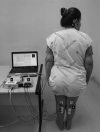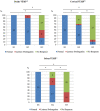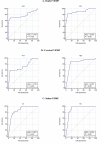Vestibular Evoked Myogenic Potential on Ocular, Cervical, and Soleus Muscles to Assess the Extent of Neurological Impairment in HTLV-1 Infection
- PMID: 32508741
- PMCID: PMC7253674
- DOI: 10.3389/fneur.2020.00433
Vestibular Evoked Myogenic Potential on Ocular, Cervical, and Soleus Muscles to Assess the Extent of Neurological Impairment in HTLV-1 Infection
Abstract
Introduction: Vestibular Evoked Myogenic Potential (VEMP) can be used to test central vestibular pathways from the midbrain to the lumbar spine, according to the muscle tested. Purpose: to compare the spinal cord alteration in individuals with HTLV-1-associated myelopathy (HAM) and with HTLV-1-asymptomatic infection using the VEMP recorded from different muscles. Methods: VEMP was recorded in 90 individuals of whom 30 had HAM, 30 were HTLV-1 asymptomatic carriers, and 30 negative controls. VEMP was recorded in the oculomotor muscle (oVEMP), testing the vestibulo-ocular reflex, and in the cervical muscle (cVEMP) and soleus muscle (sVEMP), testing the vestibulospinal reflex, respectively, in the cervical and in the lumbar spinal level. The type of stimulation was auditory for oVEMP and cVEMP, and galvanic for sVEMP. The compared variables were the latencies of the electrophysiological waves. Results: HTLV-1-asymptomatic group was similar to the controls regarding oVEMP (p = 0.461), but different regarding cVEMP (p < 0.001) and sVEMP (p < 0.001). HAM group has presented the worst latencies and was different from the HTLV-1-asymptomatic group in the VEMP of all the tested muscles (p < 0.001). The concomitant occurrence of VEMP alterations in the three recorded muscles of the same individual was found in 2 (6.7%) asymptomatic carriers and in 20 (66.7%) patients with HAM (p = 0.001). The analysis of VEMP alteration per group and per muscle has showed that, in HTLV-1-asymptomatic group, oVEMP was altered in 3 (10.0%) individuals, cVEMP in 10 (33.3%) and sVEMP in 13 (43.3%). In HAM group, oVEMP was altered in 23 (76.6%) individuals, cVEMP in 27 (90%), and sVEMP in 30 (100%). Conclusion: HTLV-1-neurological damage has followed an ascendant progression beginning at the lumbar spine in the stage of a clinically asymptomatic infection, whereas HAM has affected not only the spine, but also the midbrain.
Keywords: human T-lymphotropic virus 1; motor evoked potentials; postural balance; saccule and utricle; vestibular function tests; vestibular nerve.
Copyright © 2020 Silva, Rocha Santos, Macedo de Resende, Labanca, Caporali, Scoralick Dias and Utsch Gonçalves.
Figures






Similar articles
-
Ocular vestibular evoked myogenic potential (VEMP) reveals mesencephalic HTLV-1-associated neurological disease.PLoS One. 2019 Dec 27;14(12):e0217327. doi: 10.1371/journal.pone.0217327. eCollection 2019. PLoS One. 2019. PMID: 31881022 Free PMC article.
-
Vestibular-evoked myogenic potential triggered by galvanic vestibular stimulation may reveal subclinical alterations in human T-cell lymphotropic virus type 1-associated myelopathy.PLoS One. 2018 Jul 12;13(7):e0200536. doi: 10.1371/journal.pone.0200536. eCollection 2018. PLoS One. 2018. PMID: 30001400 Free PMC article. Clinical Trial.
-
Testing the vestibular evoked myogenic potential (VEMP) to identify subclinical neurological alterations in different phases of human T-lymphotropic virus type 1 infection.Spine J. 2013 Apr;13(4):397-401. doi: 10.1016/j.spinee.2012.11.015. Epub 2012 Dec 23. Spine J. 2013. PMID: 23267739 Clinical Trial.
-
Vestibular-evoked myogenic potentials.Handb Clin Neurol. 2016;137:133-55. doi: 10.1016/B978-0-444-63437-5.00010-8. Handb Clin Neurol. 2016. PMID: 27638068 Review.
-
New perspectives on vestibular evoked myogenic potentials.Curr Opin Neurol. 2013 Feb;26(1):74-80. doi: 10.1097/WCO.0b013e32835c5ef3. Curr Opin Neurol. 2013. PMID: 23254558 Review.
Cited by
-
Neurological aspects of HTLV-1 infection: symptoms in apparently asymptomatic carriers.J Neurovirol. 2024 Aug;30(4):353-361. doi: 10.1007/s13365-024-01197-9. Epub 2024 Apr 23. J Neurovirol. 2024. PMID: 38653958
-
Galvanic vestibular stimulation and its applications: a systematic review.Braz J Otorhinolaryngol. 2022 Nov-Dec;88 Suppl 3(Suppl 3):S202-S211. doi: 10.1016/j.bjorl.2022.05.010. Epub 2022 Jul 5. Braz J Otorhinolaryngol. 2022. PMID: 35915031 Free PMC article.
-
Galvanic vestibular stimulation for the postural rehabilitation of HTLV-1-associated myelopathy.Front Hum Neurosci. 2024 Dec 19;18:1507559. doi: 10.3389/fnhum.2024.1507559. eCollection 2024. Front Hum Neurosci. 2024. PMID: 39748916 Free PMC article.
-
Elderly people with human T-cell leukemia virus type 1-associated myelopathy present an early impairment in cognitive skills.Arq Neuropsiquiatr. 2023 Mar;81(3):253-262. doi: 10.1055/s-0043-1763486. Epub 2023 Apr 14. Arq Neuropsiquiatr. 2023. PMID: 37059435 Free PMC article.
-
Cognitive screening in HTLV-1-infected people using a self-perceived memory score and auditory P300.J Neurovirol. 2022 Feb;28(1):123-132. doi: 10.1007/s13365-021-01044-1. Epub 2022 Feb 15. J Neurovirol. 2022. PMID: 35167053
References
-
- Santos FLN, Lima FWM. Epidemiologia, fisiopatogenia e diagnóstico laboratorial da infecção pelo HTLV-1. J Bras Patol Med Lab. (2005) 41:105–16. 10.1590/S1676-24442005000200008 - DOI
-
- Seguchi T, Kyoraku Y, Kazuko Saita K, Toshihiko Ihi T, Nagai M, Akiyama Y, et al. . Human T-cell lymphotropic virus type I (HTLV-1) associated myelopathy and Sjögren's syndrome representing pulmonary nodular amyloidosis and multiple bullae: report of an autopsy case. Virchows Arch. (2006) 448:874–6. 10.1007/s00428-005-0028-x - DOI - PubMed
LinkOut - more resources
Full Text Sources

